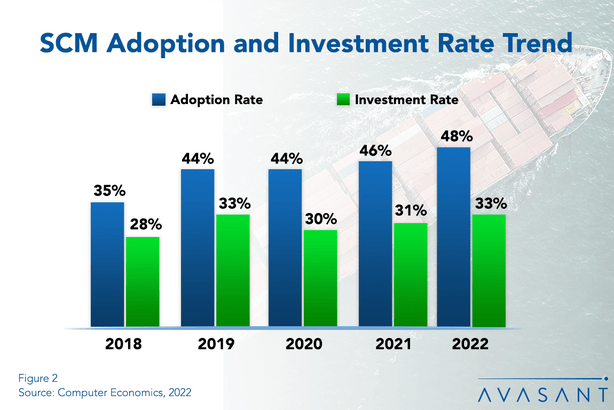Global crises continue to push supply chain management (SCM) systems to the brink. Delays and shortages have led business leaders to question their longstanding commitment to lean inventory, just-in-time manufacturing, and reliance on long, offshore supply chains. As a result, most sectors are renewing their focus on supply chain management, making new demands for supply chain technology, and increasing their need for supply chain professionals.
The percentage of IT organizations adopting SCM is rising in 2022, as shown in the blue bars in Figure 2 from our full report, . The 48% adoption rate is an increase from the 46% in 2021. However, the adoption rate is only moderate compared with the other technologies in our annual Technology Trends survey. Meanwhile, 33% of IT organizations are budgeting new money for SCM. That is up from the previous year’s 31% and the 30% in 2020. But we still rate investment as low compared with other technologies in the report.

“Empty shelves in grocery stores, and cargo ships lined up outside the ports of Los Angeles, Long Beach, and elsewhere, have made supply chains a hot topic these days,” said Tracell Frederick, research analyst for Avasant Research, based in Los Angeles. “These problems will not be resolved quickly and will no doubt fuel additional investments in supply chain technology in the coming years.”
SCM systems manage the planning, movement, and storing of materials from the earliest stages of procurement through intermediate stages of production to final distribution to the end customer. Whereas enterprise resource planning (ERP) systems focus primarily on the internal operations of the business, SCM looks outward to encompass the activities of suppliers, customers, and partners, as well as internally to the movement and storing of materials within the organization’s operations.
Although SCM systems are traditionally considered as relevant only to product-based businesses—such as manufacturing, wholesale distribution, and retail—they are increasingly being used in services businesses as well. The use of planning software, artificial intelligence (AI), and machine learning have aided the expansion into the other sectors. For example, in healthcare, the procurement and inventory of pharmaceuticals and medical supplies is a form of SCM. Moreover, pure services businesses are increasingly using the term “supply chain management” to refer to systems that are used to manage suppliers or vendor agreements.
The full report quantifies the current adoption and investment trends for SCM technology, as well as the benefits driving companies to expand their implementations. We assess these trends by organization size and sector and look at the ROI and TCO experiences of organizations that have adopted SCM. We conclude with practical advice for those planning new investments in SCM.
This Research Byte is a brief overview of our report on this subject, Supply Chain Management Adoption Trends and Customer Experience. The full report is available at no charge for subscribers, or it may be purchased by non-clients directly from our website (click for pricing).





